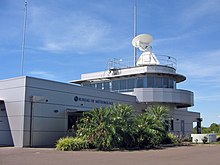Flight meteorology
The Aviation Meteorology is the branch of meteorology that deals with providing for the implementation of flight operations employs relevant meteorological information and relevant weather forecasts. The forecast models of normal meteorology are used to a large extent , but the information obtained is compiled especially for users of aviation.
Important sizes
The following quantities are of particular importance for flight meteorology:
- In aviation, visibility is the distance at which larger objects such as trees or houses can be recognized in their outlines. It is particularly important for approach and departure. A distinction is made here between:
- Ground view , the horizontal view on the ground
- Earth view , the vertical view of the earth in flight
- Flight vision , the horizontal view in the direction of flight
- The QNH is the air pressure at sea level , calculated from the air pressure at the airfield, assuming standard conditions .
- In aviation, the wind is important for calculating the flight time and amount of fuel as well as for controlling the aircraft , especially on the final approach . The direction and strength of the wind are communicated to the pilot shortly before take-off or landing by the air traffic control unit or the flight controller .
- The cloud cover and the height of the main cloud base are particularly important for air traffic at the airfield , for example to know when the cloud cover can be expected to break through. It is also important for the definition of the visual meteorological conditions .
- The temperature on the ground has an impact on the length of the taxiway at take-off, as the density of the air changes with the temperature and, accordingly, the performance of the engines.
- The dew point is the temperature at which the condensation of the water dissolved in the air just begins. The dew point difference (temperature - dew point) provides information about the likelihood of the formation of clouds or fog.
- The precipitation will affect the condition of the runway and is therefore important for the calculation of the taxi route. Particularly dangerous for aviation is supercooled rain , which turns into ice on the aircraft skin and obstructs the view, deteriorates aerodynamics and increases the mass of the aircraft .
Forms of provision
International
- The name SIGMET stands for weather reports that concern phenomena dangerous for aviation . In Germany they are broadcast on VHF frequencies by the regional meteorological checkpoints in Bremen , Düsseldorf , Frankfurt and Munich .
- VOLMET is a weather forecast for aircraft in flight. It is issued in Germany via four transmitters in Berlin-Schönefeld , Frankfurt , Hanover and Bremen and contains information about the weather conditions at airports in the Federal Republic of Germany and in neighboring countries.
- TAF messages contain weather forecasts for larger airfields.
- GAFOR refers to the aviation weather forecast for general aviation .
- AIRMET messages contain warnings about dangerous weather phenomena in the lower airspace . They are issued when required.
Germany-related
The aeronautical meteorological forecast service (AMFS) is carried out in Germany by the aviation advisory centers of the German Weather Service , which are located in Frankfurt, Essen, Hamburg, Berlin and Munich.
- INFOMET is provided by the German Weather Service by telephone.
- Pc_met refers to software and an internet portal that can be used to call up flight meteorological information.
- Glider weather reports provide detailed meteorological information for glider pilots, paragliders, hang gliders and hang gliders. They can be called up via fax and pc_met.
- Balloon weather reports(also for airships ) are distributed via INFOMET and pc_met.
See also
Individual evidence
- ↑ a b c d e f g Michael Marten: Flugfunk. Communication and navigation in aviation. Basics, technology, radio traffic, frequency lists . Baden-Baden 2005, ISBN 3-88180-624-5 , p. 71 ff .
- ↑ Information from the DWD about glider weather reports . Retrieved September 8, 2013.
- ↑ Information from the DWD on balloon weather reports . Retrieved September 8, 2013.
